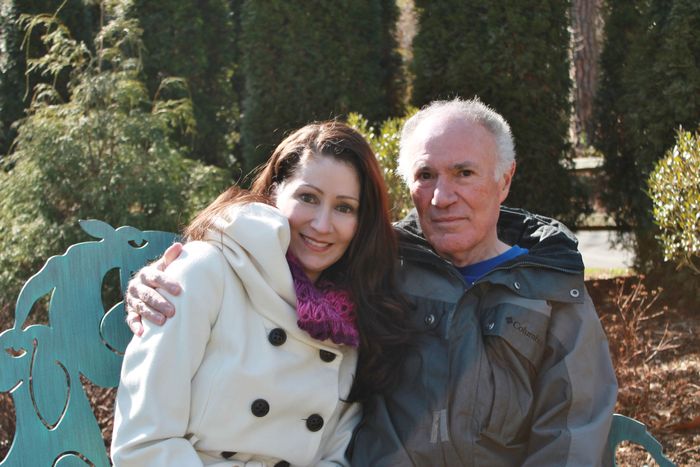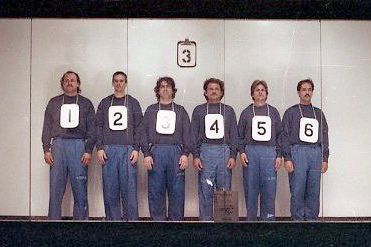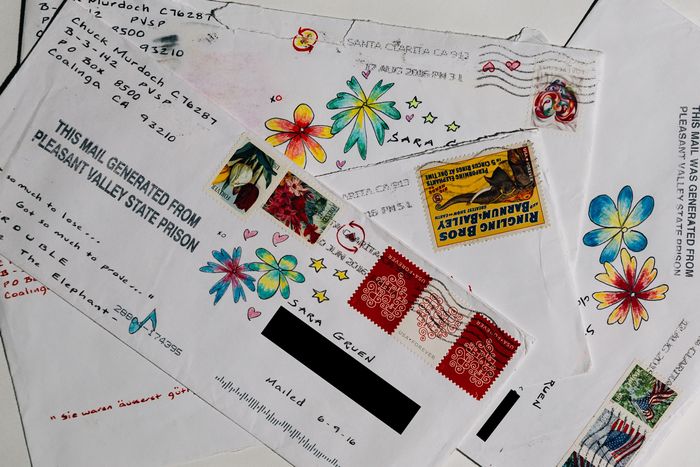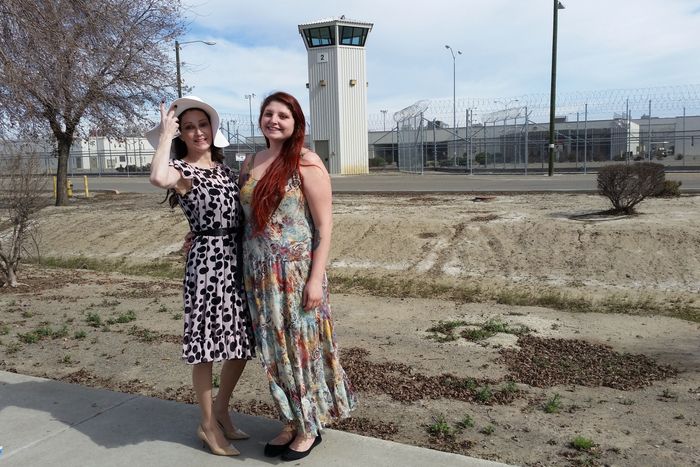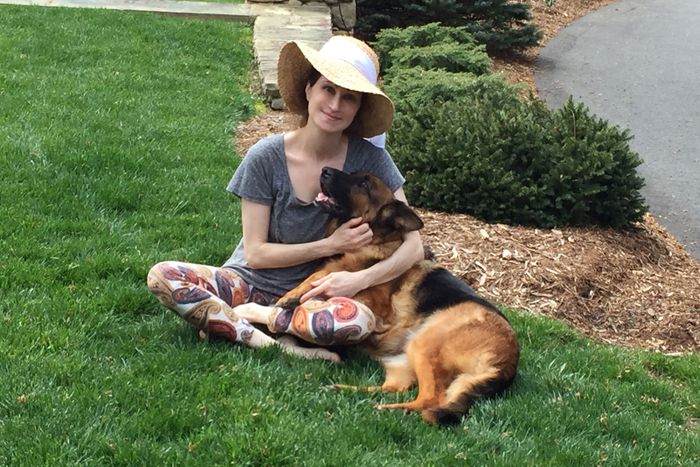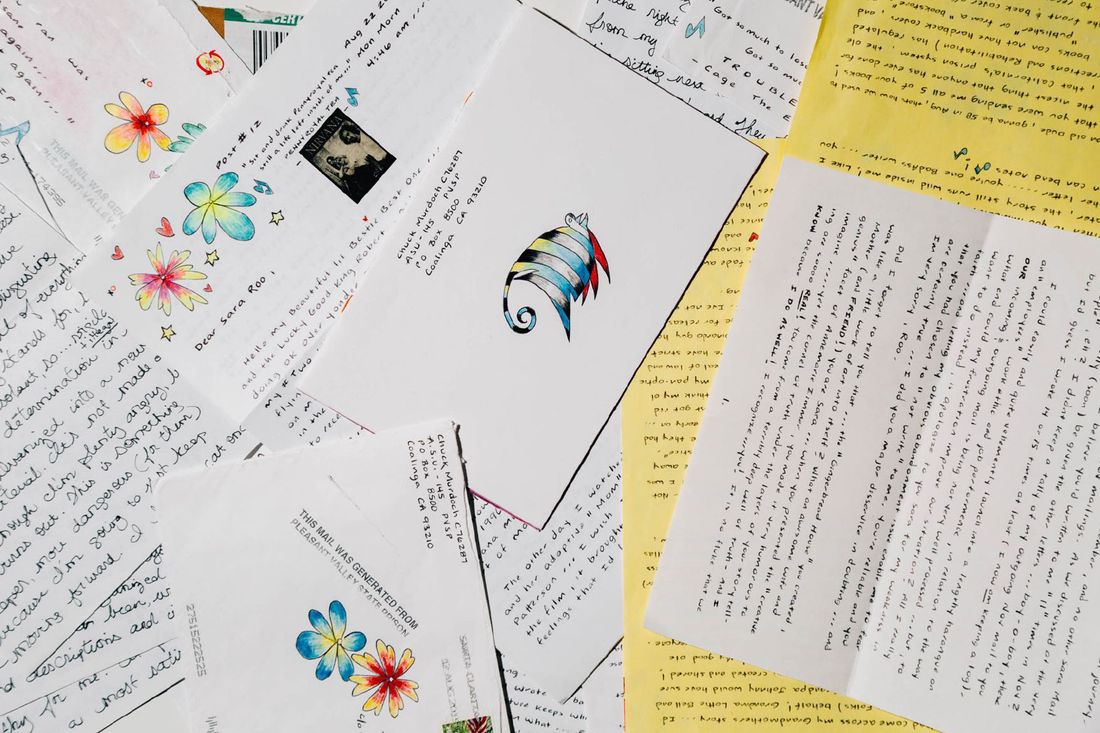
Published in partnership with The Marshall Project. This article was featured in One Great Story, New York’s reading recommendation newsletter. Sign up here to get it nightly.
It began with a letter from California’s Pleasant Valley State Prison. Since her novel Water for Elephants sold 10 million copies worldwide and inspired a movie starring Reese Witherspoon, Sara Gruen has received 60 or so letters from people behind bars, but this one was different. The sender’s name was Charles Murdoch, prisoner No. C76287, sentenced to life without parole for first-degree murder. “I just finished devouring your WATER FOR ELEPHANTS,” he wrote. “Oh man … it was AWESOME!” The 2006 book, a tale of star-crossed lovers in a traveling circus, was personal for Murdoch. When he was a kid, he wrote, his grandpa told tales of performing in an early-20th-century circus with his teenage bride, Lottie. Murdoch wondered if Sara had based one of her characters, Lottie the Aerialist, on his grandmother; if so, his “long departed grandfolks would have sure been tickled and honored.” He signed off “Respectfully, Chuck Murdoch” and added a strange moniker: “Badfish.”
The letter came from Gruen’s publisher in June 2015, which had forwarded it to her home in Asheville, North Carolina, where she lives with her husband, her son (the youngest of her three adult children), and a menagerie of pets, including horses named Tia and Fancy. Even aside from the remarkable connection to her book — Sara, 52, had indeed researched a real-life performer named Lottie — Murdoch’s letter stood out. He had created his own stationery, decorating his letter with intricate doodles: two flowers, a tiny heart, a spiky fish with neon stripes. He wrote that former chief justice Alex Kozinski of the U.S. Court of Appeals for the Ninth Circuit “described my (wrongful) conviction as ‘a truly spectacular miscarriage of justice.’”
Most surprising to Sara: Murdoch did not ask for money or help or even a response. Since publishing her book, she’d experienced a surge of readers and fans reaching out, seemingly interested in how her celebrity might benefit them. Some instances were so outrageous I might think Sara was exaggerating had I not witnessed them myself.
One reader wrote to her, musing about how easy it would be to attend an event and shoot her. Another reader, with whom Sara corresponded often on Facebook, eventually became so obsessed with her that she had to block him; a year to the day later, he committed suicide. Once, a woman in her neighborhood banged on Sara’s door for help, saying that her dog had fallen down a steep hole nearby. The woman didn’t seem to know who the author was, which she found comforting, and they became casual friends. Two months later, the woman revealed that she had known who Sara was all along and wanted access to her publishing contacts. Suspecting that the woman had gone so far as to purposely drop her dog down that hole, Sara enlisted her husband, Bob, to intervene. “Sara has been approached so many times by people wanting something from her,” he wrote to the woman, “that she has trouble trusting that those who befriend her really just want to be her friend. Too often her suspicions are warranted — and some of the people involved have actually been dangerous. Unfortunately, you now fall into the category of those who contribute to her worry about whom she can let into her life.” Such bizarre encounters affected Sara so deeply that our mutual friend nicknamed her “Sara Suspicious.”
Still, Murdoch’s letter piqued Sara’s curiosity. She spent the next hour Googling Murdoch’s case — and the next hour, and the next. She had been in the midst of researching her next novel, featuring a cast of characters whose fates collide on the Orient Express, but her outline, arranged along her walls in a sprawling web of Post-its, suddenly seemed trivial in comparison to Murdoch’s case.
Each new page about Murdoch’s twisted legal saga contained a revelation more outrageous than the last. As Sara saw it, the investigation hinged on a coerced confession, and the trial, she concluded, was marred by mercurial witnesses, the suppression of crucial evidence, and a judge who seemed motivated to secure Murdoch’s conviction. Kozinski’s idiosyncratic dissent in Murdoch’s appeal stayed with her:
“If it wasn’t for bad luck, Murdoch wouldn’t have no luck at all. He’s wakin’ up this mornin’ in jail when there’s strong proof he ain’t done nothing wrong. I would certainly defer to a jury’s contrary verdict if it had seen this evidence and convicted Murdoch after a fair trial, presided over by a fair judge, followed by an appeal where the justices considered all of his constitutional claims. But Murdoch had none of these.”
Sara uncharacteristically wrote Murdoch back. Her package contained signed copies of all of her books and a note: “May justice finally prevail.” After sending it, she immediately regretted her response. “Justice is not going to fucking prevail finally on its own,” she thought, “and that was a really asinine thing to write to a guy who’s doing life.”
She didn’t yet know that Murdoch’s letter was to change her own life. It also nearly ruined it. She is now, in her words, “absolutely broke,” “seriously ill,” and her current work in progress is “years past deadline.” Since 2016, she has been in a perpetual state of emergency. She has borrowed against her house. Death threats forced her to flee her home for months. Her health declined mysteriously and with terrifying speed. As Sara’s friend of nearly 20 years, I worried that she might die — or that if she lived, it would be as an incomplete, foreign version of herself, one incapable of coherent conversation, let alone writing books.
As a journalist, I watched, increasingly confounded, as her casual investigation of an old murder case bloomed into a frenzied obsession. Six years on, I tried to make sense of the chaos that subsumed Sara’s existence.
In the days following their initial correspondence, Sara began her own investigation of the murder case and Murdoch’s long criminal history. He was not the “fuzzy bunny of wrongfully convicted inmates,” she acknowledged. His rap sheet spanned six pages. In Long Beach, California, during the ’80s, he became known as the “Baskin-Robbins Bandit” for holding up ice-cream stores, although he insisted that his .38-caliber revolver was never loaded. He picked locations that had high-school students for clerks because they were less likely to create a problem. Before leaving, he always asked for a cone to go.
Then came the case that would lead to Murdoch’s murder conviction. On May 17, 1983, three men robbed Chris’s Horseshoe Bar in Long Beach. A patron was fatally shot, and another stabbed and critically wounded. One of the thieves left a fingerprint on the cash register, and more than a decade later, with advances in forensic science, police were able to trace it to a man named Dino Dinardo.
Homicide detective Ronald Pavek arrested him in Berkeley in June 1994. At first Dinardo denied being involved with the crime, but he recanted when presented with the fingerprint evidence. Then, according to Dinardo’s testimony at a later hearing, Pavek said that he was “interested in someone other than you” and that if Dinardo “helped them out,” things “would be all right.” Pavek later testified that he “just happened to have photographs with me of Mr. Murdoch,” which he showed to Dinardo. When Dinardo failed to come up with Murdoch’s surname, Pavek flipped the photo over so Dinardo could read it. Dinardo named Murdoch as an accomplice.
Both Dinardo and Murdoch were charged with murder and tried separately; Dinardo was first. At a hearing before his trial, Dinardo testified that the police coerced him to implicate Murdoch in the crime. He was convicted and sentenced to 25 years to life. Although judges don’t typically bargain with either the defense or prosecution teams, Judge Charles Sheldon made an unusual offer during Dinardo’s sentencing: “I have 90 days to change the sentence if anything changes in the way of your mind.” Sheldon added that Murdoch’s prosecutors had “a very difficult case” without Dinardo’s assistance and that he would be inclined to reduce the sentence should Dinardo testify against his alleged accomplice.
Dinardo agreed, but before the trial began, he sent a letter to his then-attorney, reiterating that Pavek had coerced a statement from him and had promised not to charge him with murder if he implicated Murdoch. In the letter (which was sealed under attorney-client privilege but was paraphrased by a judge who had seen it), Dinardo said, “I do not actually know Mr. Murdoch, although I know his brother. Mr. Murdoch and I did not commit any crime.”
Dinardo went on to become the prosecution’s key witness. But the jury never learned of the letter’s existence. Murdoch, accused of firing the fatal shot, was convicted of first-degree murder and sentenced to life without parole. Meanwhile, Dinardo’s sentence was reduced to 12 years for voluntary manslaughter, and he ended up serving about five.
By the time Sara received Murdoch’s letter, the California Court of Appeal had upheld Murdoch’s conviction, the state’s Supreme Court had denied his petition for review, and a federal petition to the district court was dismissed. Every prisoner who’d written to Sara claimed innocence, but Murdoch is the only one she came to believe. In her view, the only relevant point about Murdoch’s rap sheet was that he’d pleaded guilty to every crime he’d been accused of — except for the murder charge, which she considered further proof of his innocence. Her husband agreed. “I thought, ‘This is really terrible,’” Bob says today. “We naïvely thought that with Sara having a public image, we could just push it and tell people about it and someone would clear it up. But it became obvious that that wasn’t true.”
Sara and Murdoch quickly became close, corresponding about much more than just his legal woes. Murdoch told her that he, too, was a parent, a father of two girls — one of whom he’d never even hugged because she’d been born after his imprisonment. He’d grown up in the U.S. Army Housing Projects on the edge of Long Beach, close to Compton, and claimed that when he was young, his mother told him that she “should have pinched your head off and flushed it down the toilet” instead of giving birth to him. After his father was run over and killed by an 18-wheeler, his head completely crushed, 16-year-old Murdoch had to identify the body. His older step-brother hung with a rough crowd, including Dino Dinardo.
When Murdoch began doing drugs and stealing, his mother sent him to a facility for juvenile delinquents where he said he was frequently attacked. Sara, normally very reluctant to speak about her past, confided the darker parts of her own history. She spoke of being left to fend for herself at age 15, a “street urchin” who scrambled to survive.
Murdoch sent poems, greeting cards, and detailed accounts of prison life. His sign-off, “Badfish,” was often accompanied by a watercolor portrait of a surfer, Murdoch’s alter ego, free to ride the waves and feel the heat of the sun. In turn, she sent news of her sons, her novel research, her animals, and her friends. They shared triumphs and frustrations, secrets large and small. “Of course he fell in love with her,” Bob says of Murdoch. “I wasn’t bothered by it. I knew she wasn’t attracted to him. I know people want to make her into one of those women who, for whatever reason, fall in love with men in jail.”
Sara and Bob believed they were Murdoch’s best and final hope. In October 2015, four months after receiving Murdoch’s first letter, Sara hired Jeffrey Hammerschmidt, a criminal-defense attorney in Fresno. His tasks were twofold: Find new information about the 1983 murder that might prove Murdoch’s innocence, and defend him against a different, current charge for “possession of deadly weapon.” In letters to Sara, Murdoch explained the incident: A year earlier, he and another prisoner were talking in the prison common room when there was a commotion; a prisoner had been stabbed. Murdoch told Sara that he’d been standing in the wrong spot at the wrong time and was charged with possession of three shanks that the guards had found nearby.
The charge struck Sara as suspicious. Fifty-seven years old at the time of the incident, Murdoch wore a knee brace and walked with a cane. She trusted him enough to arrange and pay for an MRI of his knee to be used as evidence should the case go to court. But she hoped such a precaution would ultimately be unnecessary; if Hammerschmidt could get the prosecutor to dismiss the charges, they could then focus on the bigger picture. He estimated that this would cost her $78,000, and Sara believed it was possible that Murdoch would be free by Easter 2016.
Sara wrote an initial $7,500 retainer check and agreed to pay $20,000 per month while also continuing to investigate on her own. She transformed her “lair,” as she calls her office, into a legal war room, piling boxes of paperwork by her favorite chaise lounge, hoping to unearth anything in 10,000 pages of transcripts and records that might secure Murdoch’s release.
Each finding enraged her. No physical evidence linked Murdoch to the shooting. The bar stabbing victim, who had testified against Murdoch, admitted to being so drunk that he couldn’t even recall being attacked, and he was not shown any pictures of possible suspects in the immediate aftermath. Dyanne Spence, a bartender at Chris’s Horseshoe Bar who was considered a key witness in the original murder case, had been shown a photo of Murdoch immediately following the robbery and didn’t recognize him. Twelve years later, however, she pointed confidently to Murdoch from the witness stand. As Kozinski concluded, “There was no way the prosecution could have gotten a conviction without a miracle called Dinardo.”
Sara visited Murdoch for the first time on November 2, 2015. “I saw hope bloom across his face, and it was honestly one of the most poignant moments of my life,” she emailed me afterward. “Right up there with seeing my babies for the first time.” She tried to prepare him for the difficulties he might encounter should he finally be freed. “When you finally do let your guard down,” she wrote to him, “and learn to trust (but only those who are trustworthy — I hope you’ll let me help vet people at first) I think the enormity of what you’ve been through will hit you, and it may feel like more than you can manage … The universe has been hurtling us toward each other our whole lives.”
But spring 2016 was fast approaching and Murdoch was seemingly no closer to being released. Sara also hadn’t worked on her Orient Express novel in nine months. In touch with her on a daily basis, I began to worry about Sara’s growing fixation on the case, her willingness to put her life on hold in the hope of saving Murdoch’s. Other longtime friends and I pleaded with her to focus on her novel, even if she continued to finance the legal battle. Desperate, Sara recorded a 95-second video explaining Murdoch’s case and sent it to Dr. Phil. “If ever there was a situation that was broken and needed fixing,” she concluded, holding back tears, “it’s this. Please, Dr. Phil, help.”
Dr. Phil’s producer called. Her first question, as Sara recalls it: Was Sara in love with Murdoch? Why him, of all wrongfully convicted prisoners? She had been expecting this question. “Because he’s a goddamned human being,” she fumed. “That is categorically not the case, and I will take it very badly indeed if someone tries to frame it in that light.” I believed her. For Sara — highly competitive, monumentally stubborn, and singularly obsessive in pursuit of her goals — the battle to save Murdoch had nothing to do with a love affair; it was a challenge. She would take on the system, find new exculpatory evidence, and win.
In the meantime, she was frustrated with her lawyer’s apparent lack of progress, especially considering his fee had far exceeded the original estimate of $78,000. She believed Hammerschmidt hadn’t read the volumes of files she’d sent and was slow to respond to emails. (To me, Hammerschmidt responded: “Of course I read the files. I would estimate that I responded to more than 500 of Ms. Gruen’s emails, during the day, at night, and on weekends, often receiving and responding to multiple emails from her per day. Having spent considerable time on this case, I strongly believe Mr. Murdoch was wrongfully convicted of murder.”) After Easter had come and gone, Sara fired Hammerschmidt and hired a new team.
They seemed a perfect fit for Murdoch’s case: Robin Sax was a former prosecutor in the Los Angeles District Attorney’s Office. Steven Graff Levine previously worked for the California Supreme Court and had worked on high-profile cases involving Paris Hilton, Phil Spector, and Michael Jackson. And Luis Bolaños, a private investigator, boasted a litany of surveillance and counter-terrorism specialties. Sara agreed again to a budget of $20,000 per month. Levine considered the question of Murdoch’s guilt or innocence to be irrelevant. “Chuck was stitched up,” he told me. “Enough for me. Did he do it? I really don’t know and don’t care because he should be out.”
Levine and Sax quickly dispensed of the weapons charge by arranging a plea deal. The team then coalesced around one goal: finding new evidence so they could file another appeal. It was a nearly impossible challenge, since this new evidence had to meet one critical legal requirement: It could not have been known to Murdoch or his defense at the time of the 1994 trial. They would start by tracking down old witnesses to see if their stories had changed. At the top of the list: Dino Dinardo and Dyanne Spence. Both had already proved elusive. Given Sara’s knowledge of the case and affinity for research, at one point Bolaños suggested adding her to his private-investigator license. Murdoch’s case became her full-time job.
Her book deadline was looming, and by this point, she’d already spent more than $250,000 on Murdoch’s case and had refinanced her house. Bob, 25 years her senior, was retired, and she was her family’s sole breadwinner. She had two children in college and another in high school. “I feel like all I’m doing,” she told me in an email, “is staving off a nervous breakdown.” She began to worry about her health. She suffered from stress-induced vertigo so severe she “heard maracas” every time she turned her head.
Over the years, I often asked Sara why she continued to fight for someone’s life even as her own became endangered. Her answers were always variations on the same theme: If we don’t insist on the same standard of justice for the Murdochs of the world, how can we expect it for ourselves?
But during our interviews for this story, Sara added another layer to her answer: That she was a collector of strays — stray animals, stray causes, stray people. Growing up in London, Ontario, she was a shy and awkward loner, a violin prodigy whose best friends were feathered or furred. She has owned dozens of animals in her 52 years and treated them all with zealous devotion. She once airlifted her dog to Colorado in a private jet so it could receive a heart-valve transplant. When she discovered her cat had a paralyzed esophagus that prevented digestion, she got it a gastric-tube implant. Every three hours, day and night, she injected formula into his tube. When her horse ate a toxic plant, she ordered several blood transfusions, necessitating a hospital stay that totaled more than $10,000. She took in a friend’s daughter and raised her for years. She bought one of Murdoch’s daughters a computer and gave her $5,000 so she could return to school.
Such extravagance and generosity can seem excessive. But Sara is a stray herself — someone who, for many formative years, was hungry and terrified and desperate — and for her, those acts of selflessness are reparative, a means of resetting old fractures and evening karmic scores. In fighting other people’s battles, she gains distance from her own. In this spirit, Sara escalated her efforts in spring and summer 2016. She set up fake Facebook accounts in an attempt to find Dinardo and members of his family. Sara told me that Bolaños, via her findings, discovered that Dinardo’s family members were running a day-care center out of a garage in Long Beach. And that he sent her live updates and photographs from a sting that he’d set up, sending two agents to pose as a couple looking for day care. It went nowhere.
The team moved on to Dyanne Spence, who was proving just as difficult to find. Sara uncovered several aliases: Collins, Williams, Dekalb, Moffett, Gray, Depriest. They would try to track Spence down and hope that she recanted.
Sara still believed that Murdoch would be freed, but the entire enterprise had begun to wear on her. There seemed a clear break in her world — Before Murdoch and After Murdoch — but she dismissed any thought of retreat. “I kind of want my life back,” she told me. But she and Bob both felt they were in too deep to quit. “The more you get into it,” Bob says now, “the more money you spend, you just hate to give up. You always think you’re close. And then you think, wow, we spent a half-million here, and that’s crazy.”
In addition to her health, Sara began to worry about her safety. Her fears, and her determination to stay hidden and untraceable, weren’t completely unjustified, but clearly some degree of paranoia was setting in. She believed her phone had been wiretapped and that she was being followed during visits with Murdoch. She changed hotels numerous times during her trips to California.
She also worried about money. “I’m now officially poor,” she wrote to me. “We’re not out on the street or anything, but no more vacations and I’m going to have to start clipping coupons and stuff. On the other hand, I will have saved a man’s life.”
She hoped to make the money back. The answer came in a Christmas request from her grandchildren: “Hatchimals,” a popular interactive toy that arrived in an egg and “hatched” when rubbed. Five minutes of research convinced her that they were Generation Alpha’s answer to Cabbage Patch Kids. The retail price was $59.99, but high demand and low supply caused substantial markups online. In a four-day bidding frenzy, she bought 156 Hatchimal listings on eBay with an average price of $151, spending $23,595.31 in total. “Either I have big balls or no brains,” she emailed at the time, “or perhaps the two go together.”
After listing just three Hatchimals, pricing them from $189 to $219, she encountered a crippling setback: eBay had limited the quantity of Hatchimals listings to three per week. At this rate, she might sell another nine before Christmas, after which demand — and prices — would surely drop. She set up a Shopify account and linked to it in a long Facebook post detailing Murdoch’s case. Although she gave away several Hatchimals, criticism soon followed: “It’s sad that a lot of kids will be very upset this Christmas because of greedy people like you,” one irate commenter responded. News outlets from across the country and the world picked up the story: Time magazine, The Washington Post, The Guardian, NBC’s the Today show (with the teaser “Hatchimals are hoarded by best-selling author”).
And then came death threats, rape threats, threats to boycott her books, comparisons to child molesters. People created and abandoned enormous orders at her store using email addresses like bitchwhore@yahoo.com. “All the people purged can attend my new group ‘Fuck Sara Gruen, bitch should get raped for being a cunt,’” wrote one Facebook user. In the end, eBay relented and told Sara she could list as many as she wished. She sold out in four days, reportedly earning a profit of $6,000 for Murdoch’s legal fees, but the barrage of violent threats had terrified her deeply, reinforcing her deep-rooted distrust of anyone unknown.
She was still reeling from the experience when she received a direct message on Twitter from a man named Richard Isaac Powell: “PVSP inmate Todd Alcorn has new information. Do you have a mailing address?” Alcorn was the prisoner who had been stabbed with a shank during the fight that resulted in weapons charges against Murdoch. After some digging, she learned that Powell had been Alcorn’s bunkmate in county jail.
Searching online, she discovered the crime that landed Alcorn behind bars: He and four co-defendants had been convicted of conspiring to murder a woman who they had held captive, beaten, and stabbed. He was also a rumored member of the Aryan Nation. She found photos of the “White Pride” tattoo on his arm, though according to Powell, Alcorn isn’t a member of the Aryan Nation; he’s just a “peckerwood” — “a redneck in prison.” Sara did not respond to Powell and forwarded the message to her legal team. That same day, she received a strange Facebook friend request. The confluence of events further inflamed her fears and paranoia. She sent an email to me with the subject “I’m going to die” and said she was sure the request had come from someone inside Murdoch’s prison. “They’ve all got fucking cell phones and know my name,” she wrote, “and probably have Googled my address by now.”
Sara was convinced that one of Alcorn’s friends on the outside might attack her. She couldn’t sleep or eat, and decided to avoid going out in public unless absolutely necessary. She bought a BB gun designed to look like an authentic Smith & Wesson pistol and a level-3 Schutzhund that attacked on command. She added more security cameras; their home already had a hot wire on top of the pasture fence.
She did not tell Murdoch — whom she’d recently chastised for being “unreasonably mushy” and told to back off in his romantic overtures — of her fears; the last thing she needed was Murdoch making chivalrous pronouncements in prison that might further antagonize anyone. Still, weird things kept happening. Strange, unmarked packages began arriving at her home: a bright-blonde wig with four inches of dark roots; a “Trump-style American RAH-RAH ladies cut small tee shirt.” She didn’t know what to make of it, but she was nervous enough that she temporarily moved from her home to a downtown condo she’d bought for her father. One day, while walking her dog, she noticed two young men with shaved heads parked at the end of her street, staring at her — “mean, like a challenge.” She stared back, equally stony, until they drove off. She realized her name is on the deed for her father’s condo and that the address would be easy to find.
She decided to report all of these incidents to her legal team. “I feel like an idiot even telling you about it,” she confessed to them. “But it is all so weird, and it all happened in kind of a clump, and I couldn’t keep my mind from going to a bad place. I mean, you know the saying: Just because you’re paranoid doesn’t mean they’re not out to get you.” She grew more uneasy after hearing that Bolaños’s old investigative partner and his entire family had died, in a murder-suicide that was speculated to be an execution, during an earlier case. She sent another email to me and a mutual friend: “I really, really don’t want to alarm you but I need to just put this out there in case something happens. This thing I’m involved in is much bigger than I ever imagined. The corruption runs through the police, the DA’s office, the Attorney General and the FBI.” One member of the team, attorney Steve Levine, believed that Sara’s imagination “got the best of her,” but Sara told me to “kick and scream” and alert relatives in Canada if she suddenly went missing.
One month later, in June 2016, Bunim/Murray, the production company behind Keeping Up With the Kardashians, expressed interest in making a show about Murdoch. Sara and her legal team began contract negotiations hoping the publicity would be good for the cause. Soon afterward, they received a better offer from InVelop Entertainment, which produces reality shows such as Trading Spaces, and signed with it instead. But in January 2017, the group had a frank conversation about whether to continue cooperating on a documentary about Murdoch’s case. Still traumatized by the Hatchimals incident and ensuing threats, she worried about any further public exposure and wrote to Robin Sax for advice.
“People WILL ask if there is a romantic interest,” Sax responded. “People WILL ask if you had a fucked up childhood. People WILL ask if you are nuts … The question is whether it’s worth it or not. Is the potential exposure for Chuck worth the potential evil that comes with it? I can’t answer that for you. In many ways, I think not.”
Sara agreed, only to change her mind when InVelop producers promised to pay the full cost of all legal expenses related to the investigation if it sold the show to a network, a process that could take a few months, if it happened at all. A camera crew came to her home to shoot footage for a sizzle reel and recorded Sara as she tapped away at her computer. “They are filming me typing this right now,” she emailed. “I’m pretending it’s my book I’m writing. You know, that one … I hope at this point that this is the last thing I ever do for Chuck.”
The team took a break from trying to find Dinardo. But as they waited for news from InVelop, money remained an issue, and Bolaños offered to continue the investigation pro bono on one condition: Murdoch must agree to take a polygraph test. But Murdoch, citing the unreliability of those tests, refused. Although Sara and Bob were angry at Bolaños, and the couple’s relationship with him began to fray, they still believed in Murdoch’s innocence and decided to continue to keep paying the team for as long as they could manage. (Bolaños did not respond to multiple requests for comment.)
In March 2017, Bolaños located Dyanne Spence and her family in Tucson, Arizona. She was the only person left to place Murdoch at the scene of the crime and, more specifically, as the shooter. Bolaños spent hours talking to Spence, who was living in a psychiatric hospital. She insisted that she’d been perfectly certain in her identification of Murdoch, even 11 years after the crime. She claimed she’d been “haunted” by his eyes. She made a bizarre statement that she’d been wearing a “bunny suit” the night of the robbery and that it had “saved” her.
When I spoke with Spence’s daughter, Jamie Bales (her mother could not be reached in the facility), she described the nature of her mother’s condition by saying, “She’s paranoid, has delusions, and just isn’t ‘there’ much.” She also reported that Spence had been diagnosed with both bipolar psychosis and schizoaffective disorder. Spence’s stepmother, Lucille Collins, a retired family practitioner in Alabama, said that Spence had exhibited signs of these conditions as early as age 11, when she believed that strangers were watching her and plotting against her.
After receiving Bolaños’s reports, Sara concluded that Spence — through no fault of her own — never had any credibility to lose. And there was more encouraging news. The team reported that they had reached out to Alex Kozinski of the Ninth Circuit, the same judge who’d issued an impassioned dissent outlining all the injustices of Murdoch’s trial, who responded with a supportive email. He’d agreed to speak on the record for the documentary and sign an official letter of support to Los Angeles County’s Conviction Review Unit, charged with reconsidering possibly erroneous convictions.
“I am knocking on wood and am super, super superstitious, but I really think this is going to happen,” Sara emailed me. She felt as though she finally had room to reenter her own life. She asked Bob to take over all correspondence with both Murdoch and the team so she could finally write her novel. He agreed and sent Murdoch a letter filled with small talk and personal news: Sara’s ongoing vertigo; their son’s trip to Italy; a promise to read the memoir chapters Murdoch had recently written and sent. “Hang in there,” Bob wrote. “With Sara trying to stay focused on her book as much as possible, you’ll be hearing more from me.”
Sara opened her file, reread her research on the Orient Express, and brainstormed a protagonist named Gertie. Gazing out her lair window onto her garden, she noticed an Oriental poppy had bloomed, bright as blood and big as her fist. She took it as a positive sign.
Any distance Sara had gained from Murdoch was soon lost. Five months later, she found out he’d tattooed “Sara Roo”’ on his wrist — a nickname he’d given her and which she used to sign her letters. She had told Murdoch numerous times that she was happily married and that there would never be a romantic connection. Furious, she wrote him: “I’m mortified, horrified, embarrassed, cringing … if the media sees it, they’ll consider it confirmation of their theory that I’m cuckolding Bob and using all our combined resources to free my prison lover. If they see that tattoo, I can’t … I can’t … I don’t even know. My mental illness number just shot off the top of the barometer.”
Around the same time, she realized she was not going to meet her book deadline, set for the end of the year. “I have taken two days off in the last three months,” she wrote her literary agent, pleading for an extension. “I let Chuck’s case get in the way, and I wish I’d never heard of him and I’m sick to death of him and he’s taken a toll on every single aspect of my life, but I think I made the right decision.” She got the extension. But when Judge Kozinski abruptly retired that December — after being accused of sexual misconduct — Sara was despondent over losing their most prestigious advocate, and her brain itself began to rebel.
On Christmas Day 2017, she experienced an episode of transient global amnesia and lost hours of her memory. Her family had eaten a meal, exchanged presents, and played games, and she remembered none of it. One type of TGA can be caused by excessive alcohol consumption, but Sara doesn’t drink. She read that such episodes usually occur only once and hoped her body wouldn’t fail her again.
It complied until the spring of 2018, when she heard again from Richard Isaac Powell — a friend of Todd Alcorn, the rumored member of the Aryan Nation. In an email to her legal team, Powell said Sara’s advocacy had prompted him to write an article for the Huffington Post, saying Murdoch really had been involved in the attempt to kill his roommate with a shank. (It was never published.) Powell signed off with “RIP” — his initials — and Sara quickly spiraled. What if Alcorn and his supposed brotherhood put out a hit on her, she imagined, sending Aryan Nation members in North Carolina straight to her door? What if they already had? Sara and her husband had heard strange noises outside their home in the previous two weeks.
Around that time, Sara was on the phone with Bolaños when she got a forwarded letter from Murdoch that he’d received in prison. “Sara Gruen” was listed as the sender:
Dear Bad Luck Chuck,
We set your golden goose free. Want to know why? Because water is for elephants. Not lame bitches like you. Get comfy. You’re going to be there for a while.
Hugs and Kisses,
Dino Dinardo and the Man with the Keys to the B Yard
XOXOXO
Sara noted the past tense: set. This small detail, she later said, “amped up my terror factor by about a thousand.” Still on the phone with Bolaños, she recalls being so upset that he couldn’t understand what she was saying, so she hung up, took a picture of the letter, and sent it to him. Then, Sara says, Bolaños consulted with the FBI, called back, and said, “I need you to leave the house right now. Do you understand?”
She did, taking her son and her Schutzhund. Bob stayed behind to care for their animals. “We are having a safe room installed in the house,” she emailed me on March 6, 2018, “with an interior bullet-proof safer room.” She checked into a hotel under an assumed name, turned off location services on all of her devices, and bought a blonde wig. She moved six times in five months to make sure no one caught up with her, staying 500 miles from her family and using a burner phone to contact them. Later that month, she sent an email explaining the situation to producer Peter Schneider, who was working on a Broadway adaptation of Water for Elephants, asking if he knew of anyone with a second home who’d let her stay for a while; if Schneider didn’t respond, she planned to ask Jeff Bezos, whom she corresponded with occasionally.


At Bolaños’s urging, she posted disinformation about her location as a lure. She went out only to walk her dog. While on the lam, she opened her book file again and refocused her brain on the past: the ravages of World War I, Gertie on the Orient Express, storylines and the train itself careening. She asked for another extension.
Bob fed her updates on the case. Bolaños was planning a trip to Canada to hunt for Dinardo. Levine had fallen ill and had to take a step back. Collectively, they decided that their best hope was Sara herself — a decision greatly influenced by the fact that the Gruens were out of money. No one knew the 10,000 pages of case files better than she. She should state her case and theories to the DA’s office.
“This is the culmination of three years of work and money and it is the ONE and only chance to get him free,” Sara told me. “I have to do this. Otherwise, I’ve flushed all of everything, including missing my deadline, down the drain. And it’s still a guy’s life. If I don’t at least try to convince the DA, I have done all of this for absolutely purely nothing.”
I objected. She had spent enough and done enough. But she insisted, returned home, and prepared an extensive 50-page dossier. In her introduction, she spoke of the personal toll and the dangers she felt were present: “I have become somewhat fatalistic … some idiot wants me dead, and the truth is, if he really wants to find me, I can’t prevent it. So if he kills me, I hope it’s quick … I guess it’s another sign of my late, great naiveté, but somehow it never occurred to me that turning a solved murder back into an unsolved murder would make somebody somewhere very unhappy.”
She turned it in and hoped for the best. It could take a year for the Conviction Review Unit to review the material. In the meantime, Sara had a novel to write.
Sara prepared to focus on her novel, but this time her body refused to cooperate. She opened her file and “just flat out didn’t understand anything.” Her vertigo had come back. She had migraines and the flu and pneumonia. She couldn’t see her story anymore, so she began to reread from the beginning. Her illness persisted throughout the winter of 2018 and into the New Year, until it became clear that this was more than vertigo or the flu. She began suffering from a “brain fog” so severe she couldn’t connect one thought to the next.
She couldn’t eat or often forgot to. Her weight plummeted to 95 pounds. She fainted every day, and her adrenal glands malfunctioned. Her body no longer made enough cortisol, rendering her incapable of feeling anything but stress or fear. Her blood pressure dropped to dangerous levels; one reading reported 58/44. When her old editor at Algonquin Books emailed with the news that Water for Elephants had gone back for another 10,000-copy printing, Sara felt nothing. “I’ve turned into a feelingless Spock-Bot,” she wrote.
And then she began to disappear.
Her emails dwindled. She would not answer her phone. Her headaches were so excruciating that she could no longer work on her novel at all; the light from the monitor felt like an explosion inside her skull. She was spending her days lying in a dark room trying not to move so she wouldn’t vomit her dose of the antibiotic doxycycline, and she refused painkillers for the same reason. “I am not processing visual information properly,” she wrote. “All of this is absolutely terrifying.”
When I visited her in August 2019, she was present but not there. One of our friends had visited the week before and warned me: “The worst part is, she knows … She is still herself enough to understand how badly she is breaking.” I found her incrementally worse. She had lost the ability to form short-term memories. She asked numerous times why I’d come to Asheville and immediately forgot my answer. Her conversation looped into grand and sweeping curlicues that never connected with logic: the 2016 election, the assassination of Archduke Franz Ferdinand, the decades of malfeasance that constituted Murdoch’s case. No one knew what was wrong. She needed a battery of tests but felt too ill to keep appointments. She told me she thought she would die in her lair, and I was afraid to tell her I agreed.
Bob’s daughter from his first marriage, Margaret, a veterinary doctor at North Carolina State University, suggested that Sara’s symptoms might be a continuation of the case of cat-scratch fever that almost killed her when she was 11. Bartonella, the bacteria that causes that illness, can lie dormant for years and flare back up, especially when the afflicted is under extreme duress. This autoimmune disorder puts Sara at very high risk for COVID-19-related complications, but her treatment has been delayed owing to the pandemic. In the meantime, she found an endocrinologist who prescribed hydrocortisone and fludrocortisone to treat her low cortisol and adrenal collapse. Her brain is reviving itself, emerging from the fog, and sometimes she can pick up where she left off, envisioning how all the threads in Gertie’s story could braid together. On the days she doesn’t trust her brain, she leaves her novel file closed and instead makes intricate dioramas of her character’s world: the Art Deco furniture in Gertie’s sitting room; her tiny, gilt-edged books; the wardrobe she might wear on the Orient Express.
Bob still writes to Murdoch often — about Sara’s debilitating headaches, the money he put in Murdoch’s commissary, his continued entreaties to the Conviction Review Unit — and Sara slips in little notes of her own. After learning Murdoch was suffering from respiratory and cardiovascular issues, and fearing he might have COVID-19, she wrote to California governor Gavin Newsom in June 2020. She recounted the flaws in Murdoch’s case and her numerous efforts: the lawyers and detectives, the money both well spent and wasted, decades of a man’s life lost. “I believe in justice for each individual, as I’m confident you do,” she concluded, “and I hope you will be able to help bring justice to this case.” (Newsom never replied, and in November, Murdoch tested positive for COVID.)
This past fall, after five years of Sara’s efforts, and after numerous delays and cancellations, her legal team at last had their meeting with Los Angeles County’s Conviction Review Unit. Bob took his wife’s place on the Zoom call, explaining that she’d had a flare-up. They enumerated all of the facts Sara had accumulated over the years, beginning with star witness Dyanne Spence’s documented mental illness and the “malleable” nature of her testimony. They spoke of the letter Dino Dinardo wrote to his attorney, in which he admitted that he was coerced by police to frame Murdoch. They argued that the district attorney and judge in Murdoch’s case conspired to withhold this evidence from his defense attorney and stressed that the jury never heard of the letter at all. In a fair trial, they asked, wouldn’t this district attorney have been fired and the case immediately dismissed?
That night, Sara lay in bed, surrounded by her dogs and four new adopted kittens, and listened to the transcript. The Los Angeles District Attorney’s Office didn’t turn them down and even seemed sympathetic; now she and Bob await a final decision.
Six months later, Sara is still waiting in every aspect of her life. Because she was sick well before the pandemic, it has now been three and a half years since she’s been out socially (except for the occasional car rides Bob takes her on and or trips to the backyard to play Yahtzee with their son). She recalls vividly her last trip to the grocery store, the almost-psychedelic brightness of the vegetables and fruits. But progress on Murdoch’s case has been stalled indefinitely. The pandemic has limited the Conviction Review Unit’s ability to investigate. Levine passed away on February 17. Given all of the time and money spent, the perceived threats to her life and the decline of her health, she can’t help but feel conflicted. On some days, she still wishes she’d never heard of Charles Murdoch; how much easier life would have been, she thinks, without the stress and expense of his case, without his continued imprisonment weighing on her mind. But on others, she recalls her very first letter to Murdoch and allows herself a spark of hope: Maybe, at long last, justice will finally prevail.


